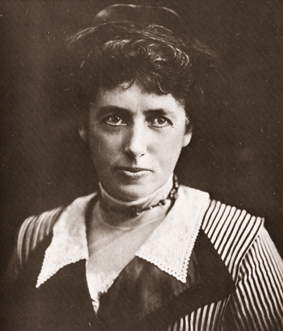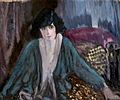Frances Hodgkins facts for kids
Quick facts for kids
Frances Hodgkins
|
|
|---|---|
 |
|
| Born | 28 April 1869 Dunedin, New Zealand
|
| Died | 13 May 1947 (aged 78) Dorchester, Dorset, England
|
| Resting place | Waikanae Cemetery |
| Nationality | New Zealander |
| Education | Columba College Dunedin School of Art and Design London Polytechnic |
| Known for | Modernist artist |
| Movement | British Modernism |
Frances Mary Hodgkins (born April 28, 1869 – died May 13, 1947) was a famous New Zealand painter. She mostly painted landscapes (pictures of nature) and still life (pictures of objects). For a short time, she also designed fabrics.
Frances was born and grew up in New Zealand. However, she spent most of her life working as an artist in England. She is known as one of New Zealand's most important and influential painters. Her most famous works were created during her time in Europe.
Contents
Early Life and Learning to Paint
Frances Hodgkins was born in Dunedin, New Zealand, in 1869. Her father, W. M. Hodgkins, was a lawyer and also an amateur painter. He was a very important person in the art world of Dunedin.
Frances and her sister, Isabel, both went to a private girls' school called Braemar House. Both sisters showed a talent for art from a young age. They both became successful landscape painters. Frances first showed her paintings of country scenes and people in 1890. She exhibited them at art societies in Christchurch and Dunedin.
In 1893, she studied with an artist named Girolamo Nerli. She painted many studies of women. One of these paintings, called Head of an Old Woman, won her a prize in 1895. From 1895 to 1896, she attended the Dunedin School of Art. After that, she became an art teacher. She saved money so she could travel and study art in England.
Becoming a Professional Artist
In 1901, Frances left New Zealand to go to Europe. She joined an art school in London. She also traveled and painted in France, the Netherlands, Italy, and Morocco. She often traveled with her friend and fellow artist, Dorothy Kate Richmond. Frances once said that Dorothy was "the dearest woman with the most beautiful face."
In 1903, one of Frances's watercolor paintings, called Fatima, was shown at the Royal Academy of Arts in London. This was the first time a work by a New Zealander was displayed there.

She returned to New Zealand in 1903. She opened a teaching studio in Wellington. In 1904, she had an art show with Dorothy Richmond. Frances got engaged to a British man that year, but the engagement ended. In 1906, she went back to London to focus on her art career.
Teaching and New Styles
In Europe, Frances had her first solo art show in London in 1907. In 1908, she moved to Paris, France. In 1910, she started teaching at Colarossi's academy in Paris. She was the first woman to be an instructor there. She also started her own School for Water Color. During this time, she showed many of her watercolor paintings at the Paris salon. She also met Canadian artist Emily Carr, whom she taught while painting seascapes in Brittany.
During World War I, she stayed in Zennor, Cornwall, England. She worked with a painter named Cedric Morris. He even painted a portrait of her in 1917. In 1915, Frances started painting with oil paints.
After the war, in 1919, she went back to France. She was influenced by artists like Matisse. However, she developed her own unique style. Her art made a big impression at her solo show in London in 1928. While in France, she met Margaret Butler, a well-known New Zealand sculptor.
In 1925, Frances began working as a fabric designer in Manchester, England. She visited a big art exhibition in Paris to get ideas for her designs.
Modern Art and Later Years
From the late 1920s, Frances's art became more modern. She used simpler, more abstract shapes and focused a lot on colors. She still painted people, but she also started mixing landscape and still life painting together. In 1929, she joined a group called the Seven and Five Society. She worked with younger artists like Barbara Hepworth, Ben Nicholson, and Henry Moore. In 1930, she encouraged her friend Lucy Wertheim to open an art gallery in London to show new artists.
Throughout the 1930s, Frances showed her art in many important galleries in London. She got a special agreement with the Lefevre Gallery to have a big art show every two years. In 1931, she painted still lifes with another New Zealand artist, Maude Burge, in France. She continued to experiment with different art styles. She even combined still life with self-portraits, but without showing her actual face.
In 1939, she was asked to represent Britain at a big art show in Venice, Italy. But because of World War II, her paintings couldn't be sent there. She was highly respected among modern artists in Britain. By the end of her career, she was known as a key figure in British Modernism.
Because of World War II, she spent the rest of her life in Britain. She continued to paint even in her seventies, even though she had health problems like rheumatism and bronchitis. She passed away in Dorchester, Dorset, on May 13, 1947. When she died, she was considered one of Britain's most important artists.
Her Legacy
The Frances Hodgkins Fellowship was created in 1962 at the University of Otago in Dunedin, New Zealand. It is named after her to honor her contributions to art.
Gallery
See also
 In Spanish: Frances Mary Hodgkins para niños
In Spanish: Frances Mary Hodgkins para niños






